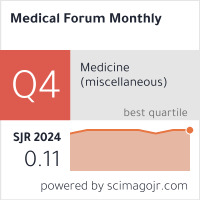A Comparative Analysis of Root Canal Preparation Methods: Assessing Obturation Quality in Rotary Versus Manual Techniques
DOI:
https://doi.org/10.60110/medforum.360512Keywords:
Root canal obturation, rotary instrumentation, manual technique, undergraduate students, T-score, adiographic assessmentAbstract
Objective: To compare the radiographic quality of root canal obturation in molar teeth prepared using rotary and manual instrumentation techniques performed by undergraduate dental students.
Study Design: Cross-sectional analytical study.
Place and Duration of Study: This study was conducted at the College of Dentistry, Qassim University, Saudi Arabia, from August 21, 2024, to March 10, 2025.
Methods: A total of 60 digital periapical radiographs of molars were retrospectively allocated into two groups based on the root canal instrumentation techniques. Group 1 (n=30): manual stainless-steel files using step-back technique and Group 2 (n=30): Pro Taper Gold (PTG) rotary nickel-titanium (NiTi) files using crown-down technique. All canals were obturated using cold lateral condensation with AH Plus sealer and appropriate gutta-percha points. The quality of obturation was assessed based on three parameters: length, density, and taper. A T-score (0–3) was calculated for each case. Statistical analysis was performed using Chi-square and Mann-Whitney U tests, with a p-value < 0.05 considered statistically significant.
Results: Adequate obturation in terms of length, density, and taper was observed in 63.33%, 46.67%, and 36.67% of teeth in the manual group, and in 83.33%, 90%, and 93.33% of teeth in the rotary group, respectively. Statistically significant differences were found in all three parameters between the two groups (p < 0.05 for length; p < 0.001 for density and taper). The overall T-score distribution also showed a significant difference favoring the rotary technique (p < 0.001). No statistically significant associations were observed between obturation quality and either gender or tooth location within the arch (p > 0.05).
Conclusion: Rotary instrumentation resulted in significantly better radiographic quality of root canal obturation compared to manual techniques. These findings support the integration of rotary systems into undergraduate endodontic training to enhance treatment outcomes.
































 This work is licensed under a
This work is licensed under a 